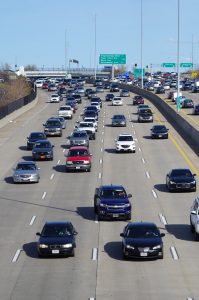
It’s no surprise to most drivers on area roadways that St. Louis has a dangerous speeding problem.
Research conducted by East-West Gateway researchers shows the St. Louis region ranks fourth highest among peer regions for speed related fatal crashes. This and other reckless driving factors such as failures to yield, distracted driving, and lack of seatbelt use caused the St. Louis region to surpass most of its peer regions in fatal crashes over a recent five-year period. From 2018 through 2022, the region had 9,576 fatal and serious crashes — an average of 1,915 per year. The region has about 300 roadway fatalities a year.
Though disturbing, the regional data presents opportunities for prevention and mitigation. Over the summer, EWG will continue its long-standing safe driving campaign with the Missouri Department of Transportation (MoDOT) that spans from Memorial Day to Labor Day. Research finds that crashes increase in summer months and on the weekends. This campaign will kick-off before the finalized June release of EWG’s comprehensive safety action plan called Gateway to Safer Roadways. The Action Plan will provide key data and maps so transportation agencies and groups can drill down on areas most in need of prevention measures and further attention. It will further include an online spatial database of “High-Injury Networks” that will highlight where the top crash locations occur in the region.
With clear data, communities can apply for funding to deploy strategies that combat what some traffic planners call the Swiss cheese model – that’s when holes in safety overlap to cause a catastrophic crash. For example, a broken sidewalk, combined with a distracted driver, and poor evening visibility drastically increases the risk of a vehicle-pedestrian crash.
Gateway to Safer Roadways is the first step in a comprehensive process that will enable jurisdictions throughout our region to apply for federal Safe Streets and Roads for All implementation grants to fund infrastructure, operational, and behavioral initiatives proven to reduce fatalities and major crashes. That funding could support local safety countermeasures, such as sidewalk extensions, lane narrowing, rumble strips, bikeways, and median barriers, to name just a few. It could further be used to capitalize on advancing vehicle technology that could be utilized by larger agencies, corporations, or governments. For example, MoDOT currently has technology that tracks and flags whether seatbelts are being used by drivers in MoDOT vehicles. And, it could be used on educational programs and public safety campaigns specifically targeted to populations found to be most at risk.
The research indicates those most vulnerable to serious injury crashes and fatalities were pedestrians, bicyclists, and motorcyclists involved in crashes with vehicles. Though overall crashes involving this group were relatively small, they were responsible for about 30 percent of the fatalities and serious injuries in the region. Pedestrian and bike accidents more frequently occur in disenfranchised neighborhoods where vehicle ownership is low, and many residents must walk or utilize alternative methods of transportation.
Though the full Action Plan will be finalized in June, its preliminary information clearly shows that our region’s roadway crashes disproportionately affect people living in disenfranchised areas. It is also clear that driver habits need corrective attention. The St. Louis region not only ranked higher than many of its regional peers in speeding and aggressive driving, but has high incidents of drivers running stop signs, using improper lanes, and tailgating. The data shows the region is also entering in the high season for crashes during the summer months– especially during the twilight and nighttime hours.
Stay tuned for further updates.

